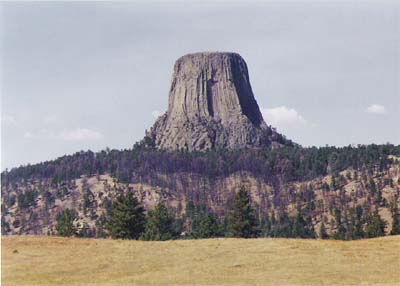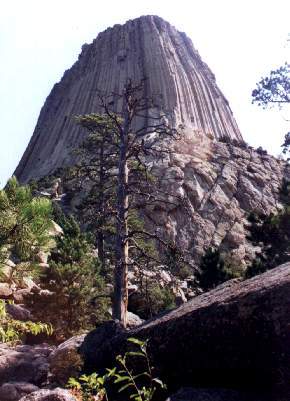pop up description layer
HOME
Cryptozoology UFO Mysteries Aviation Space & Time Dinosaurs Geology Archaeology Exploration 7 Wonders Surprising Science Troubled History Library Laboratory Attic Theater Store Index/Site Map Cyclorama
Search the Site: |
|
Weird Geology: The Devil's Tower
It is a most improbable mountain, sticking up
a thousand feet in the air above the surrounding valley like
some giant, prehistoric tree-stump. Native Americans from ancient
times designated it a sacred place. Stephen Speilberg used it
as a backdrop to his blockbuster movie Close Encounters of
the Third Kind. Yearly, thousands of tourists come to gawk
at its unusual shape. The name of this strange geological formation
is Devil's Tower.
Devil's Tower rises 1,267 feet above the nearby Belle Fourche River. What makes the mountain so striking is its sharp, near-vertical cliffs with regular, furrows and flattened top. The ancient Native Americans have several stories that explain its creation. In one two girls playing in the woods are chased by an enormous bear. The girls jump on top of a rock, but it is too small to give them safety. The Great Spirit sees the girls' predicament and causes the rock to grown to an immense size. The giant bear jumps at the girls, but cannot reach the top. His claws leave the gouges in the side of the rock that can still be seen today. That's a nice legend, but what does science tell us about the creation of this strange formation? During the age of the dinosaurs, this area was once under a shallow sea. Over a period of millions of years, sediment was deposited on the floor of this sea and this eventually turned it to sedimentary rock such as sandstone, shale and siltstone. At the end of the dinosaurs age 65 million years ago, pressures from within the earth forced the land upward. These pressures created the nearby Black Hills and Rocky Mountains. The pressure also forced molten rock toward the surface at the location where the tower now stands. What scientists cannot agree on is whether this molten rock ever made its way to the surface. If it did, then Devil's Tower is probably the remains of an ancient volcano. The formation as we see it would be called a "volcanic plug."
Most of the evidence suggests that Devil's Tower isn't the remains of an extinct volcano, however. There is no trace in the surrounding countryside of other geological phenomena that might be associated with a volcano such as ash or lava flows. A more likely theory is that the strangely-shaped mountain is a laccolith. A laccolith is an intrusion of hot magma from deep within the earth that never reaches the surface. It pushes up a bulge of sedimentary rock above it, but no caldera or crater is formed. As the molten rock cools and the soft sedimentary rock of the bulge is worn away, the harder igneous rock is exposed. If this is the case the top of the tower probably became visible between one and two million years ago. The tower itself is composed of phonolite porphyry, a gray or greenish igneous rock with crystals of feldspar embedded within it. As the hot rock cooled, eight-sided vertical columns formed. As these columns continued to cool they shrank and pulled away from each other, making the furrow marks that run vertically down the tower from the top.
As the land surrounding the tower continues to erode, more of the bottom part of the tower will be exposed. At the same time, however, the tower is not immune to erosion itself and is slowly wearing away. The boulders strewn around the base are remnants of this singular formation that have fallen from it over time. The first successful climb of Devil's Tower was in 1893. It was done using a series of ladders held to the mountain by pegs driven into some of the vertical cracks running between the columns. William Rogers, a rancher, ascended the ladder for the first "official" climb on July 4th of that year. Though the ladder has become unusable, portions of it can still be seen by visitors walking the trail that circles the base of the tower. Climbers still ascend the tower, but use free climbing techniques and safety ropes secured with steel wedges hammered into cracks in the rocks. The installation of permanent pitons are not allowed so that damage to the rock face can be avoided. The mountain is still sacred to several Northern Plains tribes, and The National Park Service, which administers the site, promotes a voluntary ban on climbing the tower in June when Native American ceremonies are most prevalent. See The Lost Gold of Devil's Tower Copyright 2004, Lee Krystek. All Rights Reserved. |
|
Related Links |
|
|




 A
volcanic plug is formed when a volcano becomes extinct and the
molten rock in tube that carried the magma from deep in the earth
to the crater of the mountain cools and becomes solid igneous
rock. Usually the rock in the tube is much tougher than the rest
of the mountain and as the wind, rain and snow erode the mountain
away, the plug becomes exposed. One well-known example of a volcanic
plug is Ship Rock in New Mexico which towers 1,700 feet
above the surrounding plain.
A
volcanic plug is formed when a volcano becomes extinct and the
molten rock in tube that carried the magma from deep in the earth
to the crater of the mountain cools and becomes solid igneous
rock. Usually the rock in the tube is much tougher than the rest
of the mountain and as the wind, rain and snow erode the mountain
away, the plug becomes exposed. One well-known example of a volcanic
plug is Ship Rock in New Mexico which towers 1,700 feet
above the surrounding plain.
